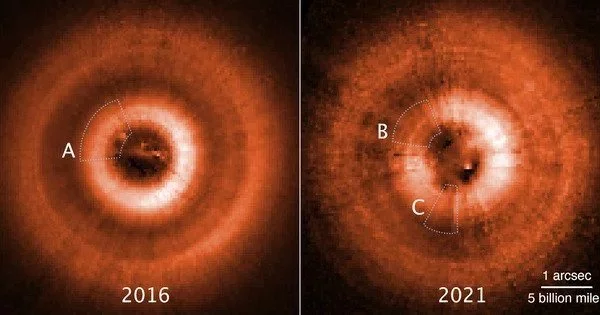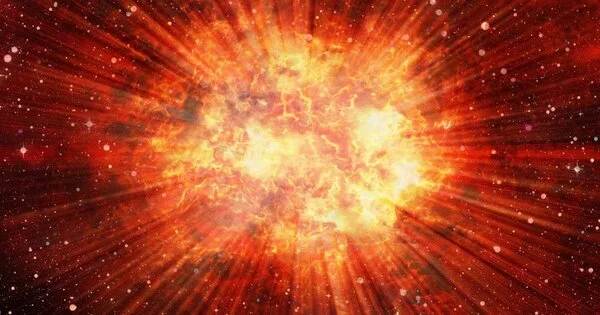Planet-forming disks are flat structures of gas and dust that surround young stars. They are also known as protoplanetary disks or circumstellar disks. These disks are thought to be the places where planets and other celestial objects are born. The study of these disks aids scientists in their understanding of the processes involved in planet formation.
TW Hydrae, a young star, is playing “shadow puppets” with scientists using NASA’s Hubble Space Telescope to observe it. Astronomers discovered a shadow sweeping across the face of a massive pancake-shaped gas-and-dust disk surrounding the red dwarf star in 2017. The shadow is cast by an inner disk that is slightly inclined relative to the much larger outer disk, causing it to cast a shadow. One explanation is that an unseen planet’s gravity is pulling dust and gas into the planet’s inclined orbit.
In just a few years, a second shadow, playing peek-a-boo, has emerged between observations stored in Hubble’s MAST archive. This could be from another disk hidden somewhere inside the system. The two disks are most likely evidence of a pair of planets in the making.
It does imply that the two planets must be relatively close to each other. If one was moving much faster than the other, earlier observations would have revealed this. It’s like two race cars racing next to each other, but one gradually overtakes and laps the other.
John Debes
TW Hydrae is less than 10 million years old and is located approximately 200 light-years away. Our solar system may have resembled the TW Hydrae system in its infancy 4.6 billion years ago. The TW Hydrae system is an ideal target for getting a bull’s-eye view of a planetary construction yard because it is nearly face-on to our view from Earth.
The second shadow was discovered during observations on June 6, 2021, as part of a multi-year program to track shadows in circumstellar disks. At the Space Telescope Science Institute in Baltimore, Maryland, John Debes of AURA/STScI for the European Space Agency compared the TW Hydrae disk to Hubble observations made several years ago.
“We found out that the shadow had done something completely different,” said Debes, principal investigator and lead author of the study published in The Astrophysical Journal. “When I first saw the data, I thought something had gone wrong with the observation because it wasn’t what I expected.” I was perplexed at first, and all of my collaborators were wondering what was going on. We really had to scratch our heads and it took us a while to actually figure out an explanation.”

The team’s best solution is that there are two misaligned disks casting shadows. They were so close in the previous observation that they were overlooked. They’ve now separated and split into two shadows over time. “We’ve never seen anything like this before on a protoplanetary disk.” “It makes the system far more complex than we anticipated,” he explained.
The misaligned disks are most likely caused by the gravitational pull of two planets in slightly different orbital planes. Hubble is piecing together a comprehensive view of the system’s architecture.
The disks may be proxies for planets that are lapping each other as they whirl around the star. It’s sort of like spinning two vinyl phonograph records at slightly different speeds. Sometimes labels will match up but then one gets ahead of the other.
“It does imply that the two planets must be relatively close to each other.” If one was moving much faster than the other, earlier observations would have revealed this. “It’s like two race cars racing next to each other, but one gradually overtakes and laps the other,” Debes explained.
The suspected planets are in an area roughly the size of Jupiter from our Sun. Furthermore, the shadows complete one rotation around the star every 15 years – the orbital period expected at that distance from the star.
Also, these two inner disks are inclined about five to seven degrees relative to the plane of the outer disk. This is comparable to the range of orbital inclinations inside our solar system. “This is right in line with typical solar system style architecture,” said Debes.
The outer disk on which the shadows fall may extend several times the radius of our solar system’s Kuiper belt. This larger disk has an unusual gap at twice the average distance between Pluto and the Sun. This could be evidence for the presence of a third planet in the system.
Any inner planets would be difficult to detect because their light would be obscured by the star’s glare. Furthermore, dust in the system would reduce the reflected light. The ESA’s Gaia space observatory may be able to detect a wobble in the star if Jupiter-mass planets are tugging on it, but due to the long orbital periods, this would take years.
















